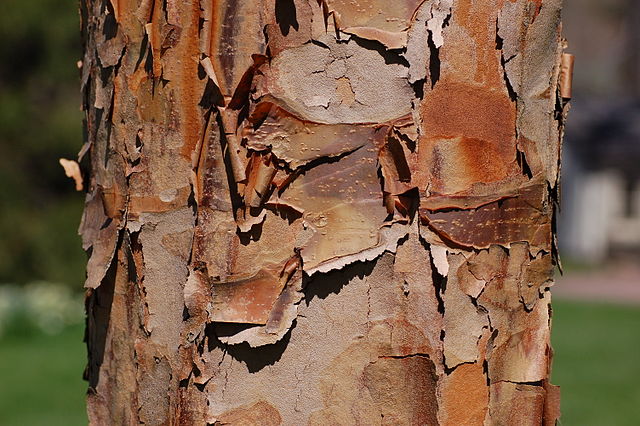Introduction
Paperbark maple (Acer griseum), also called Chinese paperbark maple or paper-barked maple, is a flowering tree in the family Sapindaceae. It is indigenous to the forests of Central China. Though once common in its native territory, deforestation and a lack of conservation have caused it to become endangered. Paperbark maple is a popular ornamental tree in Europe and the United States. It is renown for its copper-colored, exfoliating bark.
Distribution & Habitat
Paperbark maple can be found in China, but has become increasingly rare. The specimens that do exist tend to grow in isolation, and be large in stature. The tree is widespread across much of Europe and the United States, where it is a popular ornamental plant.
Developmental Traits
Paperbark maple is deciduous. It has a slow growth rate, gaining 6 to 12 inches a year. It reaches maturity after 12 to 15 years. When young, paperbark maple has an upright-oval to oval-rounded growth habit. As the tree matures, it assumes an upright-rounded habit. The branches formed by paperbark maple are slender, and grow upward. Paperbark maple can be pruned in late fall or winter, when the plant is dormant.
Longevity
Paperbark maple has a short life-span, living 40 to 150 years.
Height
Paperbark maple is a small to medium sized tree. It can reach 20 to 30 feet tall, with a 15 to 25 foot spread. The trunk can measure up to 28 inches in circumference.
Bark
Paperbark maple has distinctly smooth bark that curls into large, papery layers. The curls will often remain attached to the tree. The bark begins exfoliating by the third or fourth year of the tree’s development. The outer bark has a copper orange to reddish-brown coloration. It turns orange to red in fall. The inner bark is tan to rose colored or brown.
Leaves
Paperbark maple leaves are trifoliate; each leaf features three coarsely toothed leaflets. The middle leaflet is short-stalked. The upper leaf surface is dark green, while the lower leaf surface is blue-green to gray-green, and laden with fine hairs. In fall, the leaves turn a range of colors: from shades of orange and red to reddish-green or brown-green. The leaves grow 3 to 6 inches long.
Flowers
Paperbark maple produces inconspicuous yellow blooms from April to early May. The flowers form in clusters. They are attached to pendulous corymbs. Pollinators are attracted to the blooms in spring and summer.
Fruit
In summer, the blooms are shed, and give way to paired samaras, with two winged seeds. The samaras can grow up 1 ¼ inches long. Each samara contains large seeds about 1 cm long. The seeds are larger than those produced by other maple trees. The seeds are disseminated by the wind to nearby locations, where they germinate in the soil, and take root. Only about 5% of the seeds end up being viable.
Propagation
Due to its low viability rate, paperbark maple is notoriously difficult to propagate from seed. Propagation from cuttings is more efficient, but can also be challenging. Juvenile cuttings are preferred over woody cuttings, as the latter often have difficulty establishing roots.
Soil & Topography
Paperbark maple prefers partial shade to full sun. It can be grown in average, slightly acidic, moist, clay, and well-drained soils. It is most partial to moist, well-drained soils. It tolerates clay soils, and exhibits a moderate resistance to salt.
Root Development
Paperbark maple develops a sturdy root system. The roots are moderately susceptible to rotting when exposed to excess moisture. The tree requires watering at least once a week, especially when drought is persistent.
Pruning
Paperbark maple is a slow growing plant. As such, extensive pruning is seldom required. Maintenance pruning should be performed each year to strip out any dead or diseased branches. Pruning should be avoided in spring, as the tree will weep sap. This can be taxing on the tree, especially during extended periods of drought. Paperbark maple can be pruned in fall or winter, after the tree has become dormant.
Damaging Agents and Pests
Paperbark maple is resistant to most insects and disease pathogens. It is vulnerable to Armillaria and Verticillium root rot, as well as aphids, and horse chestnut scale.
Cultivation
Several cultivars have been derived from paperbark maple. The most widely available are ‘Cinnamon Flake’, ‘Fireburst’, and ‘Gingerbread’. ‘Cinnamon Flake’ is similar to the parent species, but features bark that peels into smaller strips. ‘Fireburst’ has a narrow, upright form, with the exfoliating bark of the parent species, but a vibrant red fall color. ‘Gingerbread’, also called ‘Ginzam’, grows at a faster rate, and has finer bark.
Uses
- Paperbark maple can be maintained as a dwarf tree, making it an excellent bonsai subject.
- In Europe, paperbark maple has been granted the Royal Horticultural Society’s Award of Garden Merit.
- Paperbark maple is widely used as an accent tree on corners, in parks, and near utilities, decks, patios, and residential buildings.
- Paperbark maple is an ideal selection for locations where clay soil is common.
- The flowers attract birds and pollinators.
If you have any questions about paperbark maple, or you are interested in one of our tree services, contact us at 978-468-6688, or Sales@IronTreeService.com. We are available 24/7, and can accommodate any schedule. All estimates are free of charge. We look forward to hearing from you.
Photo courtesy of Derek Ramsey CC-by-3.0


